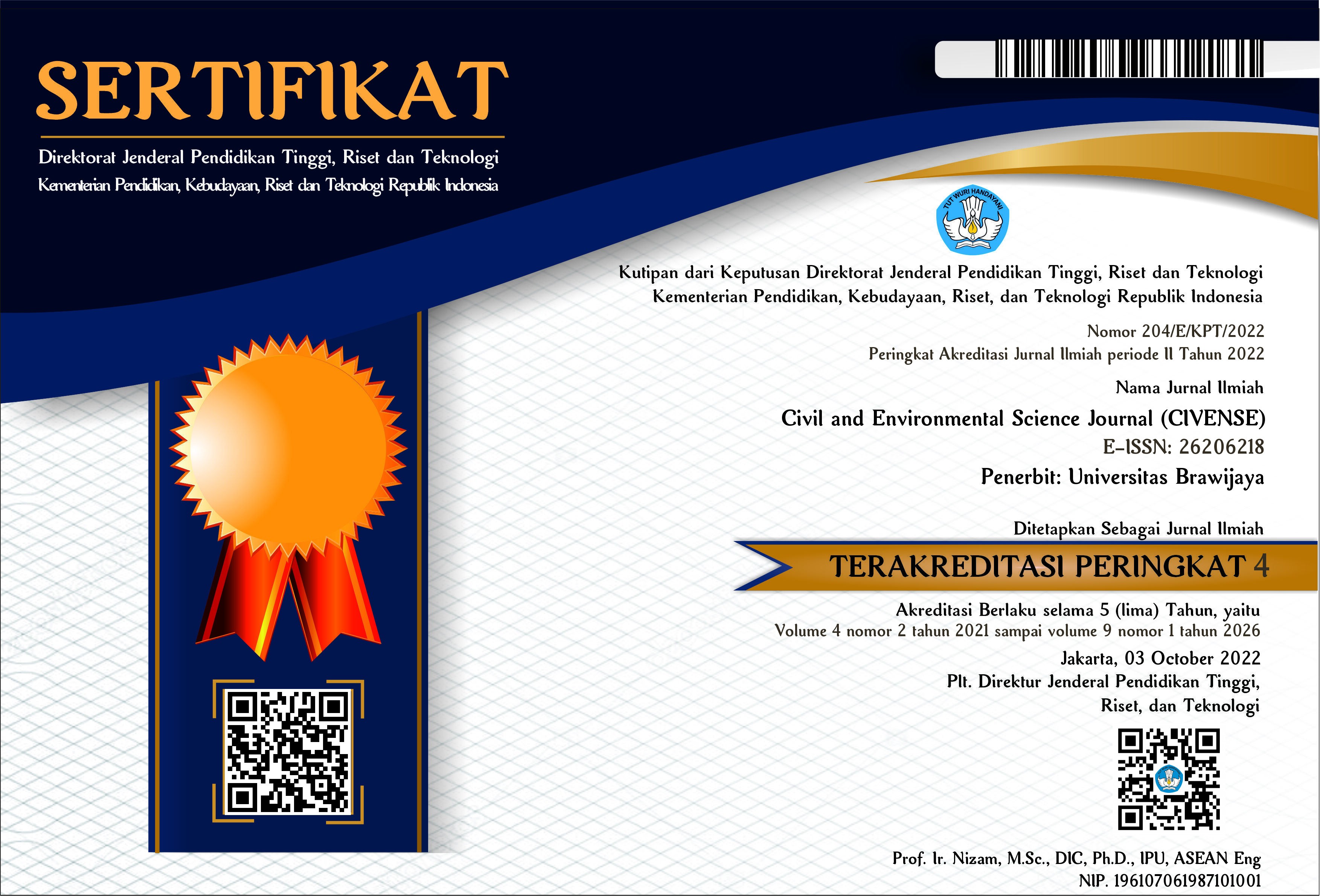Author Guidelines
Types of paper
Civil and Environmental Science Journal (CIVENSE) received articles in an original research paper, review paper, and case study.
Original research paper
Original research paper is an article that reports detailed research and classified as primary literature. Its format includes an introduction and background problems, hypotheses, methods, results, interpretation of findings, and discussion sections. This paper is generally long, with word count ranging from 3000 to 6000.
Review paper
A review paper is an article that provides up-to-date report on the current situation regarding certain important topics on regional and rural studies. It discusses previous development from the topic and gives an overview of the future. In general, a review paper is usually long, ranging from 3000 to 5000 words or even more, depending on the case being reviewed.
Case study
A case study is an article compiled by practitioners presenting details of unique cases on the regional and rural studies. The cases are usually those that contribute significantly to the knowledge in the field. This article is expected to discuss the signs, symptoms, diagnosis, and problem solving or repair on vehicles.
General structure of original research paper and case study
Paper identity
The title should be short and simple. After the title of the manuscript, followed by the names of authors and affiliation. Last is the complete contact information for the corresponding author, including the email address.
Abstract
The abstract section is created in a single paragraph. The first sentence generally states the purpose of the experiment and the next sentence explains how the investigation is conducted. The next sentence presents an overview of the experimental results and the last sentence describes the significance of the results and their impact on the field of study in general. Add 3-6 strong keywords.
Introduction
The introduction of a manuscript includes a brief overview of the literature relating to the research topic. Introduction is generally written descriptively, beginning with a broad topic and slowly focusing on the work being done. An introduction usually requires several paragraphs beginning with one or two paragraphs that introduce the reader to the field of the problem under investigation in general. Then, in the next paragraph explains something more specific. The last paragraph is very important, which is what experimental questions will be answered by a study and how to do it.
Method
The research method contains a direct description of the methods used in a study. The method contains the statement of the materials used in the study, the main procedures, the techniques used in the data retrieval, and the analysis techniques. If the research uses a particular experimental design, the method part also includes the design/set up of the research. Similarly, for literature research, theoretical or modeling components are also clearly contained in this section.
Result and discussion
The results present experimental data to the reader. The results (which are also research findings) are generally presented in tables and figures that are interesting and clear. This section of the discussion contains interpretations of research results to give meaning to the reader or provide guidance for further research. All figures and tables need further explanation to reveal the truth.
Conclusion
The conclusion contains a summary of the research findings. Then, followed by the main points of the discussion. A general conclusion ends with a statement about how the research work contributes to the field of study as a whole.
Acknowledgment
This section contains a statement of funding sources for the research work. This section also contains gratitude to those who contributed to the research and preparation of the manuscripts.
References
This section lists all the references cited in the text. Civil and Environmental Science Journal (CIVENSE) using IEEE style. Citation and reference systems must use the Reference Management System such as Mendeley, EndNote, Zotero.
General structure of review paper
Paper identity
The identity of the article review is the same as the original research paper, which includes the title, author, affiliation, and email of the corresponding author.
Abstract
Write in one or two sentences that describe the context and purpose of the review. Then, explain in one or several sentences to give a general description of the methodological approach, including the material and data used. Then, write down a few sentences that describe the main results. Finally, close by the conclusion linked to the objectives. Add 3-6 strong keywords
Introduction
The introduction of a review article is more concise than the original research paper. Introduction generally consists of three main paragraphs, containing:
1. Background: contains general topics, issues, or areas of concern to illustrate the context.
2. Problems studied: contains trends, new perspectives, gaps, or conflicts between findings.
3. Motivation/justification: contains the author's reason for reviewing the literature.
Material and method
The material and methods section contains for example information on data sources, data search strategies, selection criteria of articles included in the review, the amount of research included, and the methods or statistics for its analysis. The researcher must ensure that the data source is clearly identified and valid.
Result and discussion (main section)
The structure of the main part of a review article needs to be a coherent topic arrangement. The main sections are generally divided into sub-sections, such as methodological approaches, models or theories, studies that correspond to other unsuitable versus studies, chronological order, to the geographical location of the reviewed study.
Each paragraph consists of one idea, one aspect, or one topic. In the review article, one paragraph refers to several studies so that the citation per paragraph more. Each paragraph links the findings of the studies discussed with the research questions listed in the introduction. This link creates the article coherence thread that is being created. By linking one study to another, a comparison of the findings will be obtained as a material for discussion. This body text section generally consists of 70-90% of the entire article, excluding identity and reference. As an important note, the author must ensure that the review of the article is written based on the idea, not based on the literature.
Conclusion
The conclusions in the review article differ slightly from the conclusions of the original research paper. The conclusions generally contain the implications of the findings, the interpretation by the authors, and the identification of unresolved recital questions.
Acknowledgment
Acknowledgment in the review article is slightly different from the original research paper. It generally contains gratitude to the people or institutions that assist in the search and supply of literature and data, material arrangement, or process of writing.
References
References to review articles are generally not less than 20 referenced sources and all are expressed in text. Civil and Environmental Science Journal (CIVENSE) uses IEEE system. Citation and reference systems must use the Reference Management System such as Mendeley, EndNote, Zotero.













